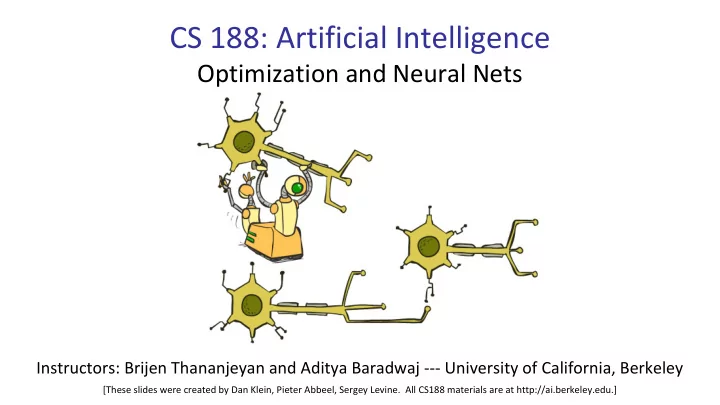

CS 188: Artificial Intelligence Optimization and Neural Nets Instructors: Brijen Thananjeyan and Aditya Baradwaj --- University of California, Berkeley [These slides were created by Dan Klein, Pieter Abbeel, Sergey Levine. All CS188 materials are at http://ai.berkeley.edu.]
Logistic Regression: How to Learn? ▪ Maximum likelihood estimation ▪ Maximum conditional likelihood estimation
Best w? ▪ Maximum likelihood estimation: with: = Multi-Class Logistic Regression
Hill Climbing ▪ Recall from CSPs lecture: simple, general idea ▪ Start wherever ▪ Repeat: move to the best neighboring state ▪ If no neighbors better than current, quit ▪ What’s particularly tricky when hill-climbing for multiclass logistic regression? • Optimization over a continuous space • Infinitely many neighbors! • How to do this efficiently?
1-D Optimization ▪ Could evaluate and ▪ Then step in best direction ▪ Or, evaluate derivative: ▪ Tells which direction to step into
2-D Optimization Source: offconvex.org
Gradient Ascent ▪ Perform update in uphill direction for each coordinate ▪ The steeper the slope (i.e. the higher the derivative) the bigger the step for that coordinate ▪ E.g., consider: ▪ Updates: ▪ Updates in vector notation: with: = gradient
Gradient Ascent ▪ Idea: ▪ Start somewhere ▪ Repeat: Take a step in the gradient direction Figure source: Mathworks
What is the Steepest Direction? ▪ First-Order Taylor Expansion: ▪ Steepest Descent Direction: ▪ Recall: ▪ Hence, solution: Gradient direction = steepest direction!
Gradient in n dimensions
Optimization Procedure: Gradient Ascent ▪ init ▪ for iter = 1, 2, … ▪ : learning rate --- tweaking parameter that needs to be chosen carefully ▪ How? Try multiple choices ▪ Crude rule of thumb: update changes about 0.1 – 1 %
Batch Gradient Ascent on the Log Likelihood Objective ▪ init ▪ for iter = 1, 2, …
Stochastic Gradient Ascent on the Log Likelihood Objective Observation: once gradient on one training example has been computed, might as well incorporate before computing next one ▪ init ▪ for iter = 1, 2, … ▪ pick random j
Mini-Batch Gradient Ascent on the Log Likelihood Objective Observation: gradient over small set of training examples (=mini-batch) can be computed in parallel, might as well do that instead of a single one ▪ init ▪ for iter = 1, 2, … ▪ pick random subset of training examples J
Gradient for Logistic Regression ▪ Recall perceptron: ▪ Classify with current weights ▪ If correct (i.e., y=y*), no change! ▪ If wrong: adjust the weight vector by adding or subtracting the feature vector. Subtract if y* is -1.
Neural Networks
Multi-class Logistic Regression ▪ = special case of neural network f 1 (x) z 1 s o f 2 (x) f t z 2 f 3 (x) m a x … z 3 f K (x)
Deep Neural Network = Also learn the features! f 1 (x) z 1 s o f 2 (x) f t z 2 f 3 (x) m a x … z 3 f K (x)
Deep Neural Network = Also learn the features! x 1 f 1 (x) s o x 2 f 2 (x) f … t x 3 f 3 (x) m a … … … … x … x L f K (x) g = nonlinear activation function
Deep Neural Network = Also learn the features! x 1 s o x 2 f … t x 3 m a … … … … x … x L g = nonlinear activation function
Common Activation Functions [source: MIT 6.S191 introtodeeplearning.com]
Deep Neural Network: Also Learn the Features! ▪ Training the deep neural network is just like logistic regression: just w tends to be a much, much larger vector ☺ just run gradient ascent + stop when log likelihood of hold-out data starts to decrease
Neural Networks Properties ▪ Theorem (Universal Function Approximators). A two-layer neural network with a sufficient number of neurons can approximate any continuous function to any desired accuracy. ▪ Practical considerations ▪ Can be seen as learning the features ▪ Large number of neurons ▪ Danger for overfitting ▪ (hence early stopping!)
Neural Net Demo! https://playground.tensorflow.org/
How about computing all the derivatives? ▪ Derivatives tables: [source: http://hyperphysics.phy-astr.gsu.edu/hbase/Math/derfunc.html
How about computing all the derivatives? ■ But neural net f is never one of those? ■ No problem: CHAIN RULE: If Then Derivatives can be computed by following well-defined procedures
Automatic Differentiation ▪ Automatic differentiation software ▪ e.g. Theano, TensorFlow, PyTorch, Chainer ▪ Only need to program the function g(x,y,w) ▪ Can automatically compute all derivatives w.r.t. all entries in w ▪ This is typically done by caching info during forward computation pass of f, and then doing a backward pass = “backpropagation” ▪ Autodiff / Backpropagation can often be done at computational cost comparable to the forward pass ▪ Need to know this exists ▪ How this is done? -- outside of scope of CS188
Summary of Key Ideas ▪ Optimize probability of label given input ▪ Continuous optimization ▪ Gradient ascent: ▪ Compute steepest uphill direction = gradient (= just vector of partial derivatives) ▪ Take step in the gradient direction ▪ Repeat (until held-out data accuracy starts to drop = “early stopping”) ▪ Deep neural nets ▪ Last layer = still logistic regression ▪ Now also many more layers before this last layer ▪ = computing the features ▪ the features are learned rather than hand-designed ▪ Universal function approximation theorem ▪ If neural net is large enough ▪ Then neural net can represent any continuous mapping from input to output with arbitrary accuracy ▪ But remember: need to avoid overfitting / memorizing the training data early stopping! ▪ Automatic differentiation gives the derivatives efficiently (how? = outside of scope of 188)
Recommend
More recommend